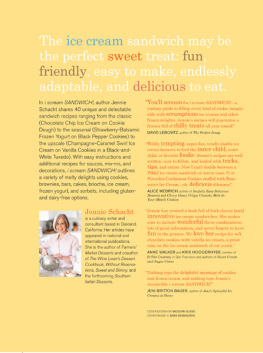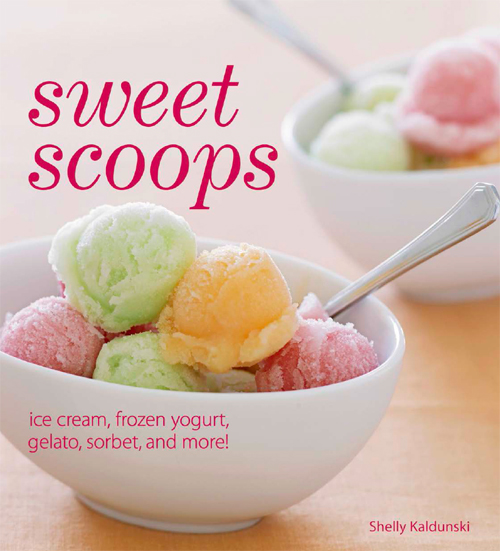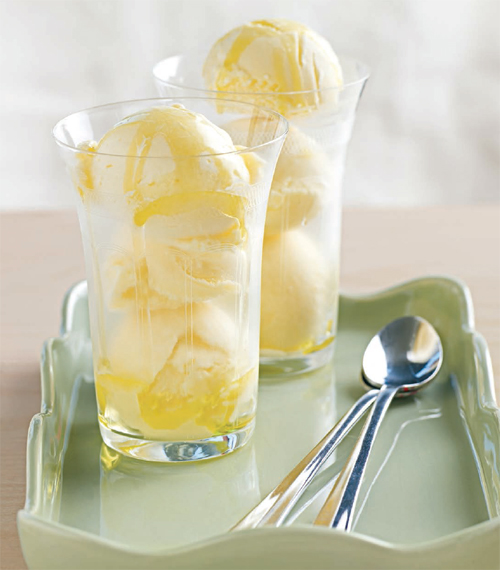i scream, you scream
For most of us, our fondest memories of enjoying ice cream are from childhood. They include balmy summer nights, the jingle of an ice cream truck, the sand and the sun, neighborhood walks, and family and friends. If the ice cream was made at home, it was an all-day event involving a big wooden bucket, bags of rock salt, and lots of elbow grease to churn out a delicious frozen treat.
Today, with the new electric machines, making ice cream doesnt have to take all day, and its not just a dessert for kids. Along with other frozen confections like gelato, sorbet, and granita, ice cream has gained sophistication over the past few years. It has found its way onto fancy restaurant menus, where a variety of scoops are offered la carte, or sorbets and granitas are served as palate cleansers between courses and as lighter dessert options during the warm months.
In this book, we begin with recipes for the best of the classic ice cream and gelato flavors, such as Vanilla Bean, Strawberry, and Espresso Ice Creams and Pistachio Gelato. Then, we draw on the recent trend toward creative flavors by offering recipes for what we call modern ice creams and gelatos. These include twists on classic flavors, like Salted Caramel Ice Cream and Mascarpone-Hazelnut Gelato, or ice creams featuring unexpected ingredients, as in Lavender Ice Cream with Honeyed Pine Nuts, Meyer LemonOlive Oil Ice Cream, or Jasmine Tea Ice Cream with Chocolate Slivers.
Recipes for creamy sherbets, soft frozen yogurts, and refreshing sorbets and granitasalong with a chapter covering cones, cookies, sauces, and toppingscomplete this frozen dessertlovers recipe collection. These are treats that everyone will love.
modern flavors
Boutique-like ice cream shops and gelaterias, now opening across the United States, are playing with creative flavor combinations. Using the highest-quality dairy products, these shops make the classic flavors as well as some with surprising ingredients, such as avocado, passion fruit, basil, sea salt, curry powder, and tea.

ice cream styles
French-style, or custard-style, ice cream is often called classic ice cream. Egg yolks, cream, and flavorings are cooked to make a custard, which is then churned and frozen in an ice cream maker. Philadelphia-style ice cream is made without egg yolks, so its less rich than French-style ice cream. The lighter base works especially well for fruit ice creams because the fresh flavors of the fruit can shine through. Other ice creams that have emulsifiers as ingredients, like peanut butter, are also often made without egg yolks.
the scoop on the scoops
The presence or absence of a dairy product, or even the type of dairy used, can mean the difference between sorbet and sherbet or ice cream and gelato. Heres a guide to help you decipher the terms.
ICE CREAM Traditional ice cream is made from a mixture of a dairy product (cream or a mixture of milk and cream), a sweetener (usually granulated or brown sugar), and flavorings (like chocolate, fruit, or nuts). Many ice creams contain egg yolks (see sidebar at left).
GELATO Soft and creamy, this Italian-style treat is traditionally made with milk, not cream, and egg yolks, though some versions include cream and exclude eggs. The signature silky texture of gelato is due less to the ingredients used and more to the way it is churned, in a machine that incorporates less air and freezes at a higher temperature than an ice cream maker.
FROZEN YOGURT & SHERBET Frozen yogurt is a softer, tangier alternative to ice cream. It can be made using non-fat, low-fat, or full-fat yogurt. For creamier results, you can also use Greek-style yogurt, which is higher in fat than plain yogurt. Sherbet is made with a base of fruit pure and sugar to which a dairy product, such as buttermilk or cream, is added for creaminess.
SORBET Sorbet is usually made with a mixture of a fruit pure, water, and sugar, which can then be frozen in a standard ice cream maker. Because sorbet has few other ingredients, the flavor is often quite intense.
GRANITA & ICE Granita is an Italian-style dessert made with a sugar syrup and flavorings that is frozen in a shallow pan. During the freezing process, it is scraped periodically with a fork to create a granular texture. Flavored ices are similar to granitas, but are often finer in texture. Both granitas and ices can be or ice cubes.

more than the sum of its parts
Since they use so few ingredients, the best frozen treats are made with the finest ingredients you can find. When possible, try to use organic dairy products, seasonal fruits, and quality spices and liqueurs.
MILK, CREAM & EGGS In these recipes, the ratio of whole milk to heavy cream is important so that the resulting texture is creamy, but not too heavy. In some cases, ingredients such as crme frache or mascarpone cheese contribute creaminess, too, so the quantity of cream in the recipe is reduced. Egg yolks give French-style ice cream and gelato a luxurious mouthfeel. All of the recipes in this book use large grade A eggs. Avoid using extra-large or jumbo eggs, since they have significantly larger yolks and can throw off the results of the recipes.
FRUIT Fresh, seasonal fruits are delicious in ice creams, gelatos, frozen yogurts, and sherbets. Some fruits have high water contents and can sometimes, if not cooked first or if added in excess, make frozen desserts overly icy. Cooking the fruit first reduces the amount of water added and concentrates the flavorsits also a good way to make the most of not-quite-ripe fruits. If fruits are out of season, use high-quality, unsweetened frozen fruits.
CHOCOLATE, NUTS & OTHER FLAVORINGS Choose the best chocolate you can find; it will be creamier when melted than some lower-quality brands and will not contribute a waxy mouthfeel. Buy nuts whole and in bulk at a store where the product turnover is high. Toast or grind the nuts up to a few hours before you make the ice cream. Also, look for vanilla beans that are soft and pliable, not stiff and dry. For smooth ice creams with subtle flavor, ingredients like nuts or coffee beans are heated with the cream (and/or milk), and then removed when the cooked custard is strained. Chunkier mix-ins are often added at the end of churning.
sweeteners
Sugar plays a role in all of the frozen treats in this book. Using the right amount of sugar is crucial: too much can inhibit freezing, making ice creams too soft and granitas slushy. For French-style ice cream, sugar is whisked with egg yolks and then dissolves during the cooking of the custard. Brown sugar is sometimes used in place of granulated sugar for a deeper flavor. Flavored sugar syrups are the bases for all the granitas and ices. Corn syrup, used in sherbets, adds creaminess and compensates for the lack of butterfat in the recipe.
















